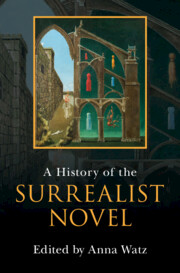Book contents
- A History of the Surrealist Novel
- A History of the Surrealist Novel
- Copyright page
- Dedication
- Contents
- Figures
- Contributors
- Acknowledgements
- Introduction
- I Marvellous Beginnings
- Chapter 1 Autobiography
- Chapter 2 Diverging Genealogies of the Surrealist Unconscious
- Chapter 3 Automatism, Autobiography, and Thanatography in the Surrealist Novel
- Chapter 4 Urban Nature: The City in the Surrealist Novel
- Chapter 5 Nostalgia and Childhood in the Surrealist Novel
- Chapter 6 Surrealist Collage Narrative
- II Transgression and Excess
- III Science, Alchemy, Nature
- IV Transnational Surrealism
- Index
Chapter 3 - Automatism, Autobiography, and Thanatography in the Surrealist Novel
from I - Marvellous Beginnings
Published online by Cambridge University Press: 02 February 2023
- A History of the Surrealist Novel
- A History of the Surrealist Novel
- Copyright page
- Dedication
- Contents
- Figures
- Contributors
- Acknowledgements
- Introduction
- I Marvellous Beginnings
- Chapter 1 Autobiography
- Chapter 2 Diverging Genealogies of the Surrealist Unconscious
- Chapter 3 Automatism, Autobiography, and Thanatography in the Surrealist Novel
- Chapter 4 Urban Nature: The City in the Surrealist Novel
- Chapter 5 Nostalgia and Childhood in the Surrealist Novel
- Chapter 6 Surrealist Collage Narrative
- II Transgression and Excess
- III Science, Alchemy, Nature
- IV Transnational Surrealism
- Index
Summary
This essay explores the nature and significance of the intersection of surrealist automatism and autobiography in the surrealist novel through an analysis of Aurora (1927–8; pub. 1946), by Michel Leiris, as compared with other surrealist novels such as Louis Aragon’s Anicet, or the Panorama (1921). Hoping to recover from a major emotional crisis, Leiris embarked upon a five-month trip to Egypt and Greece in 1927. Commenced during this journey, Aurora combines surrealist approaches with fictional and documentary elements in an investigation of the limits and fluid expanses of the writing self. How does automatism at once reinforce and obliterate the autobiographical source? In Aurora, surrealist automatism and elements of autobiography become epistemological demonstrations, via the words of the writer who is writing in real time, of the sheer fact of being alive and the possibility of impending death. Therefore, Aurora also experiments with thanatography, which is a written account of the death of the self. One way of understanding Aurora, Leiris asserts, is as a surrealist magnum opus, or account of the alchemical striving towards the creation of the philosopher’s stone recast as the surrealist path to greater awareness of a fundamentally unknowable, unbounded, and unstable self.
- Type
- Chapter
- Information
- A History of the Surrealist Novel , pp. 56 - 71Publisher: Cambridge University PressPrint publication year: 2023

